Joshua Tree, Tahquitz, North Ridge of Lone Pine Peak, and the Northeast Ridge of Bear Creek Spire
JTTNRoLPPNeRoBCS
A Mockery of Acronyms and At Least Part of the Story of How I Learned to Climb and Discovered Freedom in The Mountains
I was stuck on the 210 freeway on my way to Redlands to pick up some Five Ten approach shoes. Man the traffic was bad, parking lot bad. I arrived in the early evening just as the store was closing. I pleaded with the friendly store employees, ‘Please, I’ve been driving for days and I won’t be able to climb the North Ridge of Lone Pine Peak (NRoLPP) without these things!’ To these pleas they graciously acquiesced, helping me find a pair of shoes. However I would not arrive in Lone Pine until just before midnight. I had been on the road from Ventura for over 10 hours. Never again will I try to drive across Los Angeles on a Friday afternoon.
I met Jonathan at the pizza place in Lone Pine and we headed up to Movie Road to meet Erik, our mountain guide with Alpine Skills International. I had worked with Erik in the past: less than a year ago, over New Year’s weekend 2015, I learned how to tie in and belay at Joshua Tree through a Vertical Adventures introductory climbing course. Now I was preparing to take on a real bona fide alpine climb. Amazing.
With so little experience, I can’t exactly compare various climbing locations, rock types and the techniques required to climb them, but I have a good feeling about everything I learned at Joshua Tree. I’m glad I learned to climb there as it tore down a lot of my pre-existing notions about rock climbing. I thought climbing was all upper body strength – huge built guys ripping up the rock, screaming and grunting with every powerful move up the face. I was pleasantly surprised how zen it all was: by the second day of climbing I found myself delicately and deliberately shifting my balance, dropping my heels, feeling the smallest bumps and textures on the slab to become in tune with the rock. It was very satisfying to 1) feel totally safe on top rope and 2) listen to coaching from the guides regarding what to look for on the rock and how to make the moves.
I stayed on for another two days to work through the anchor building class. My favorite part about this class was playing around with the trad gears. With just me and one other student in the class, Erik was able to critique a wide variety of our placements, including hexes and nuts in constrictions, cams in parallel vertical and horizontal cracks, tricams in odd little pockets, and so on. We learned various ways to rig primary placements together (I prefer the checklist RENE: redundant, equalized, no extension). And we climbed some more and learned a few extra skills here and there, such as how to use an autoblock to back up a rappel, and how to safely arrange a top rope at Joshua Tree (bring 100 ft of static rope to tie off refrigerator size boulders laying flat on their side!). I felt safe just looking at the big honking knot, or BHK, or BFK, whatever you prefer. By the time I left my head was spinning. I quickly picked up Climbing Anchors by John Long and Bob Gaines and began studying it to reinforce everything I had learned in the class.
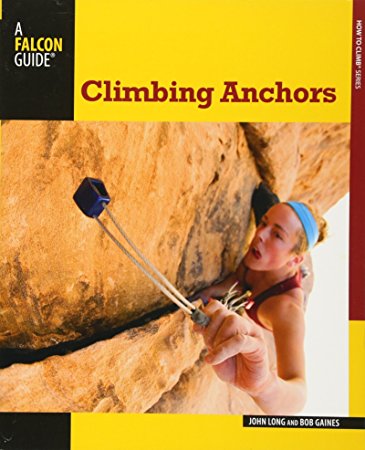
The thought of combining rock climbing skills with some of the mountain sense I gained scrambling around the Sierra Nevada last summer was nothing short of thrilling. All the great armchair adventuring available online only stoked my desire to tackle at least a few of these routes the coming summer. However I realized I was still extremely, truly scarily, inexperienced. I seem to recall Erik mentioning it takes years and years of regular climbing to become a 100% proficient lead climber and that this could best be accomplished by following an experienced lead climber. So I tempered my expectations a bit. As the next step forward Erik suggested we meet for a multi-pitch climb at Tahquitz above the town of Idyllwild. I had never heard of Tahquitz before, but with a little research I learned of its prominent place in California climbing lore and the stellar granite to be found there. Game on!
We met in town on a fine July morning. The route for the day would be White Maiden’s Walkaway, rated at old school 5.1. During the hike up to the base of the route Erik explained the sequence of communication we were to use on the climb. During the climb it went like this:
Erik: On belay?
Jeff: Belay is on.
Erik: Climbing.
Jeff: Climb on.
As a first time lead-belayer I recall just once failing to pay out enough rope while Erik was on lead. Erik was pretty pissed, and for good reason, as a mistake like this could actually pull the leader off the rock. I appreciated his honesty and refusal to coddle me after the mistake. I won’t do that again! By the time Erik reached the end of the pitch I listened closely to hear:
Erik: Off belay!
Jeff: Thank you!
I would then take the belay off.
Jeff: Belay is off!
After waiting for a short while for Erik to pull up the slack in the rope, I listened for:
Erik: Belay is on!
After cleaning the anchor I was tied into, I yelled back:
Jeff: Climbing!
Erik: Climb on!
And I was off. I was so focused on the rhythms of the multi-pitch climb that I remember only a few of the actual moves. At one point I got my foot stuck pretty solidly after a jam. Erik advised me to jam my foot just well enough to support the move, but for reasons abudantly clear to me at the time, to avoid going full jam. Never go full jam. I studied each of Erik’s primary placements, and often after cleaning a piece, I put it back where it was myself, just to really feel out the placement. I noticed Erik favored tricams at the belay anchor, as using them here saved cams for the lead climbing. And at the belay it is possible to keep a close eye on the tricams to be sure they don’t wiggle out of position. I also noted he skillfully flipped the rope pile to arrange his end of the rope on top, reducing the likelihood I had to deal with any rope tangles while belaying. I would never have thought of this myself. About halfway through the climb we took a short break, and I looked down for the first time. I couldn’t believe how comfortable I felt staring over the precipice. I was beginning to trust the roped safety system. Of course this was easy as Erik was the one building the anchors!
We got right up to the last pitch in no time, and Erik brought up the possiblity of going for a more direct finish, which involved a challenging move. I was feeling good and without thinking too much agreed, ‘Yeah! Let’s do it!’ Well I reached the move and jammed my right hand into a crack up high above my head (learning at a timely moment that a hand jam is not produced by cupping your fingers forward, but instead by sliding your hand in flat, and then bringing the thumb forward to increase the thickness on the meaty part of your hand). Now with my hand jammed in I had to swing my body left over a big rounded bulge to complete the move. However I was reluctant to swing as there was a lot of air beneath this one. Erik was just above at the belay and said what I wasn’t quite ready to hear, ‘You’re trying to edge, Jeff, where there isn’t any edge! Swing your body over and get some friction with your feet!’ To which I thought, ‘All right let’s do this! Hyahh!!’ And just like that I made the move. Challenging yeah, feels good, is good. As I reached the belay I realized that throughout the climb, Erik had placed gear only to protect difficult moves. Before the climb, I imagined climbers placing tons of gear wherever the rock would take it. But of course placing gear only at the most difficult (or exposed) moves makes much more sense and surely allows a leader to climb more quickly.
The last pitch was easy as we made our way up the rounded slab beneath the summit. I signed the register and we ate lunch, enjoyed the mountain scenery, and discussed climbing goals and our mutual disdain for smart phones and being plugged in all the time. Fittingly I had not even bothered to bring a camera to document the day’s activity.
Before the climb I had entertained the idea of climbing two routes in a day, but my new rock shoes fit pretty tight and my dogs were barking. That idea was out, but it was a great climb nonetheless. The more I looked around the scenery, laying out in the mountain sun, the more I appreciated the beauty of Idyllwild. For the hike down, I switched out the rock shoes for my old basketball high tops (Erik had recommended I pack an extra pair of shoes at the base of the climb), and was glad I could. My feet felt great and I noted the importance of having the appropriate footwear for the job…which now brings us full circle…Not long ago I was driving down the terrible 210 freeway on my way to Redlands to pick up some Five Ten approach shoes…
After picking up some Guide tennies, I stopped at a Panera in Redlands to unwind from that nightmare of a drive. I was spent! Thankfully by the time I finished eating dinner, traffic had begun to ease up. Heading north, and leaving the city behind, felt good. Jonathan and I finally rolled up to Movie Road not long before midnight and found Erik sleeping soundly behind his van. We decided to save introductions for the morning and shoved off to bed ourselves.
We were up with the sun. Erik was surprised to even see us, but of course was glad we made it. The first order of business was lightening our loads as much as possible. We planned to climb the NRoLPP in two days with a bivouac on the ridge. I tossed my water filter and Whisperlite stove in the car, since Erik had iodine tablets and a Jetboil cooker. Then I gave Jonathan my lightweight 45° F down bag so he could leave his heavy 0° F bag behind. Soon enough we were packing up the Meysan Lakes trail, looking for a ramp leading to a notch that would get us on the ridge. Just one week earlier I had hiked up this trail en route to a bonanza of bagged peaks, including Mallory, McAdie, and LeConte with friends Craig and Dagmar. On that trip Craig and I scoped out the notch, and now this week Erik, Jonathan, and I were able to confidently head off a faint climbers trail toward it. I guzzled water at the creek crossing, and we filled up our various water containers, sanitizing the supply with the iodine tablets. Per Erik’s instruction, we bled the last few unpurified drops by flipping each container upside down and delicately unscrewing the cap for a moment.

Now, finally, we started climbing! Erik gave Jonathan and I the chance to do some route-finding during the scrambling sections, a dynamic that would continue throughout the climb. It was rewarding to pick out lines that looked good, and get feedback from Erik whether he agreed with our choices or not. Of course he had the final say, which was for the best. My motivation for climbing with a guide was not to climb any particular route, or bag any particular peak, but rather to experience trad climbing in the alpine. Erik’s patience and teaching ability was a good match for my ambitions.
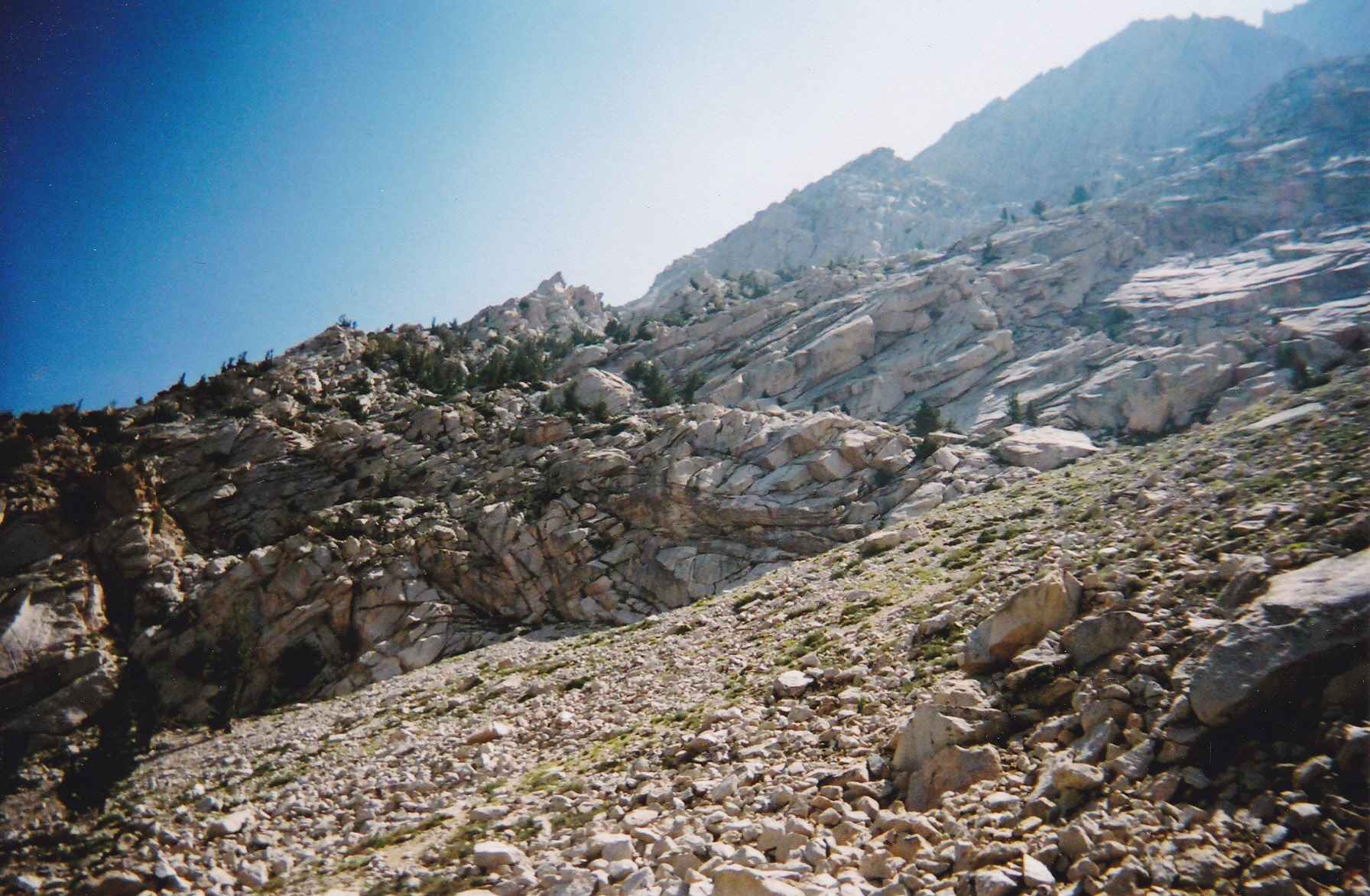
And I was amazed at how much I was able to learn during the climb. I was most curious about how we would manage the rope with a three man team. Just two weeks earlier, I had climbed Mt Humphreys with John and David. During that climb, I led the last exposed class four stretch, belayed John up, had John unrope on easy terrain, and finally tossed the rope down to David successfully on the second try. I was fairly certain this was not the preferred means to climb as a three man team, especially given the requisite blind rope tosses and the possibility of the rope getting stuck. Now on the NRoLPP, I learned a much better method (with a single rope): Erik instructed me to tie in to the end of the rope like usual, and then he tied a figure eight on a bight about seven or eight feet from my tie in point. Jonathan clipped into the bight with reversed and opposed lockers on his belay loop. With this setup, Erik led everything and belayed Jonathan and me up at the same time.
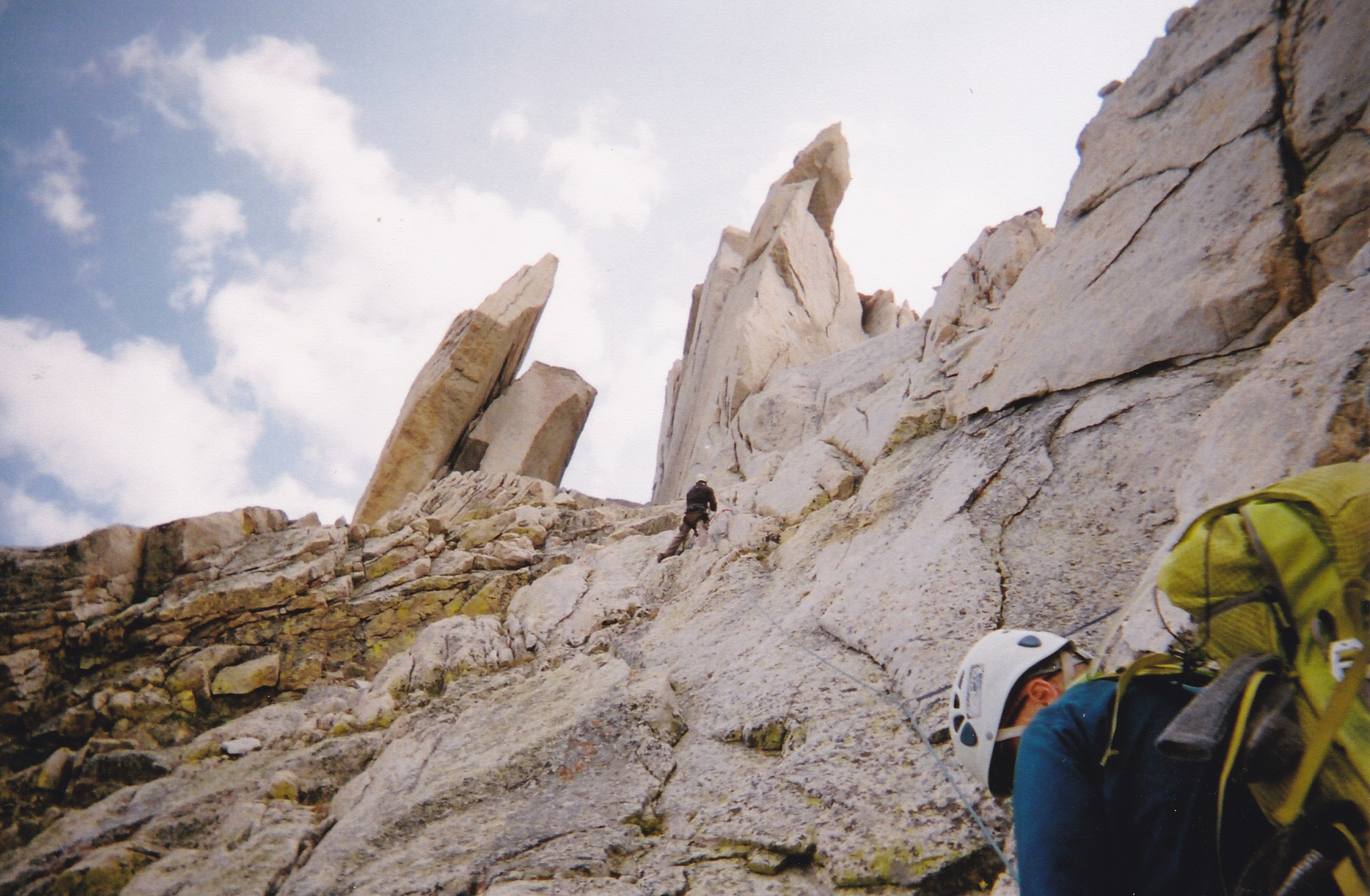
But wait, there’s more!…learning! During an easy but steep downclimb, Erik belayed Jonathan and I one at a time by simply wedging himself between a couple of large boulders. I asked, ‘Don’t you have to place some gear and rig an anchor?’ To which he replied, ‘Jeff, there is no way you could pull me up over this bulge and out of this stance. Using my weight and stance as an anchor is quick, easy, and good enough in this situation.’ Incredible. Of course the belayed downclimb is much more suitable during a guiding situation, as the guide must inevitably solo it.

The moves on the North Ridge were not so memorable, but I had a blast nonetheless. The ridge has a lot of scrambling and easy fifth class terrain. After the short initial downclimb, we moved up a tilted seam, climbed through two mythic slanted jagged pillars of tremendous proportion (to which I ascribe the names Huginn and Muninn, ravens on the shoulder of Odin), downclimbed a bizarre arrangement of rounded flakes once again under the safety of Erik’s belay, and lastly traversed blocky terrain up to luxurious sandy bivouac ledges, where we spent the night. I was relieved when Erik found the ledges as the sun was starting to get a little low in the sky.
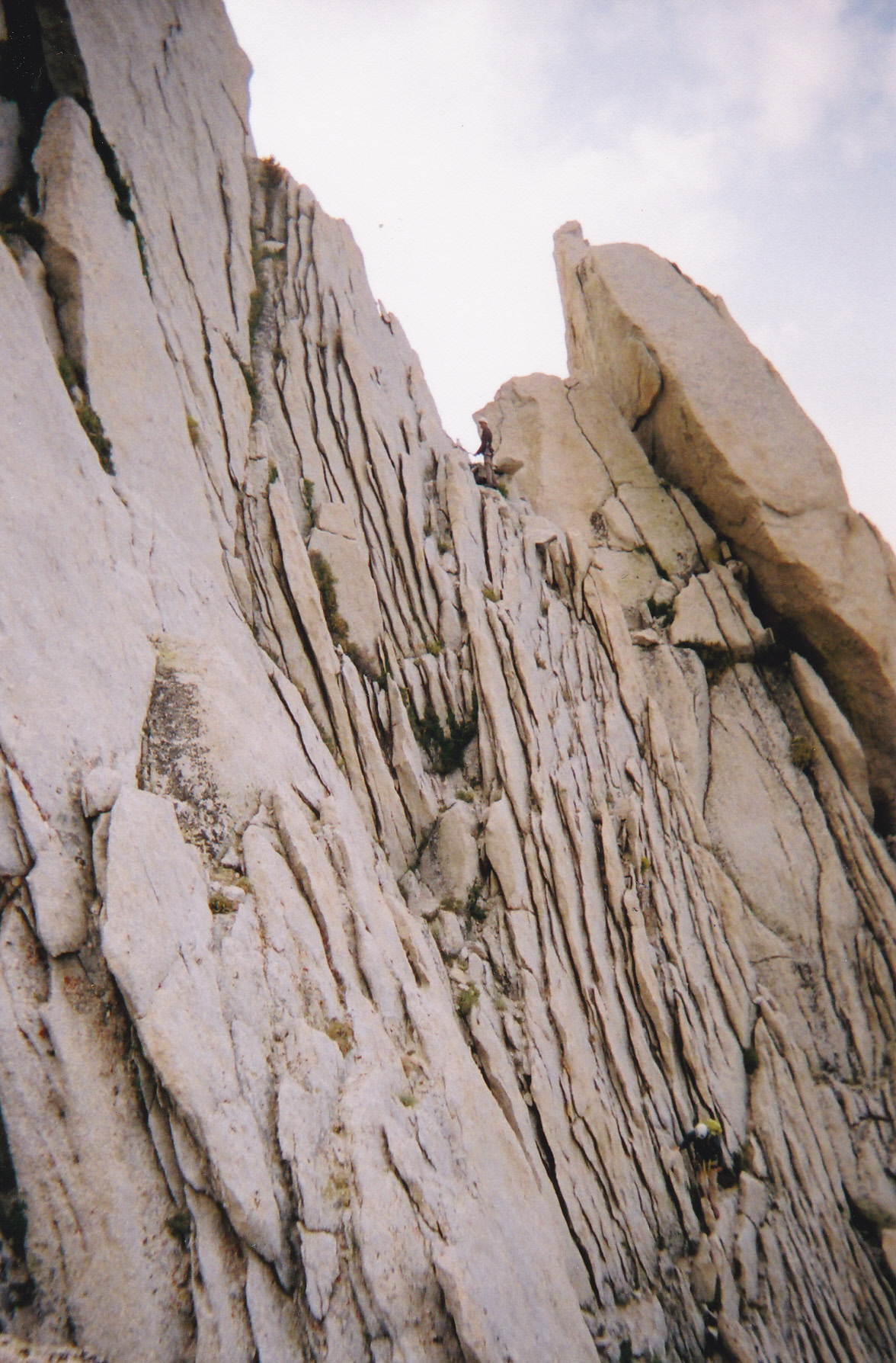
Erik graciously gave Jonathan and I the premium spots and himself wandered to a slightly more exposed spot down the way. We cooked dinner in the Jetboil and discussed the day’s events. I had never spent a night on the mountain and was loving it. Mt Whitney and Her guard of pinnacles stood unwavering in the brilliant waxing alpenglow so near to us, only to fade suddenly into the night. Erik reminded us to mind our food supply against the onslaught of mountain rats scurrying in the night. ‘Rats?! Up here?!’ I exclaimed. I slept great on the soft sand and was glad to find my food undisturbed come morning.

Just as the alpenglow on Mt Whitney marked the end of the first half of our adventure, so it heralded in a new and promising day of climbing, day two of NRoLPP! After scanning the steep face above our bivy sites, Erik led up and over the crux layback crack. As advertised, there was an old timey piton hammered in there. However, there were some nice grooves on the slab next to the crack, and I was able to face climb the slab, no problem. The rest of the day would see us pitch out the entire route on terrain that I just maybe….maybe might have been all right scrambling. ‘Nevermind the terrain,’ I thought to myself, ‘there’s plenty of pitches ahead, so soak up all the trad climbing you can!’

We took a break before downclimbing into the final notch (where I found a really nice Patagonia jacket) beneath the summit headwall to eat and drink, replenishing our energy reserves for the final push. Erik offered us some cheese and crackers and sausage, which I happily gobbled up. In keeping with the atmosphere of sharing I gave Jonathan a couple of my Fig Newtons. It was another calm bluebird day – a great day to be in the mountains.

After reaching the notch, Erik led through a tricky move to the first belay on the headwall. The move required a delicate foot smear to step around a slight bulge, followed by a hand traverse up and over to easier terrain. I noticed that Erik placed two pieces of protection in the hand crack during the short traverse. Looking at my picture now, I notice he shortened the slings so the rope would run closer to the pieces. I had never thought about configuring slings differently to manage the rope through a pitch. Since the pitch was on the difficult side, Erik decided to belay Jonathan and me up individually. I relaxed in the notch and provided what I believe is called a ‘fireman’s belay’ for Jonathan should he slip off during the short traverse. Well Jonathan got up to the hand crack, and he was pumped! It was agonizing to hear him yelling and screaming, unable to pull himself through the move. His arms were cramping awfully. I honestly can’t remember how Erik worked this out, but somehow Jonathan’s pack ended up with me at the belay, allowing Jonathan to pull the move and finally reach Erik. I picked up Jonathan’s pack and remarked, ‘Damn this thing is heavy!’ Before I knew it Erik was hauling Jonathan’s pack up the pitch. I cleaned the pitch and pulled through the move without any trouble, and Erik and I each took some of Jonathan’s gear to lighten his load.

Now that we were finally on the summit headwall, it looked big. I’m pretty certain we were climbing with a 60 meter rope and knocked off five or six full length pitches on the headwall. Jonathan started to move more and more slowly as the day wore on, and I started shoving him up some of the more difficult moves – one of the advantages of climbing as a team of three! I decided I was glad to be roped up as every now and then we would encounter some easy fifth class, certainly beyond my scrambling comfort zone.
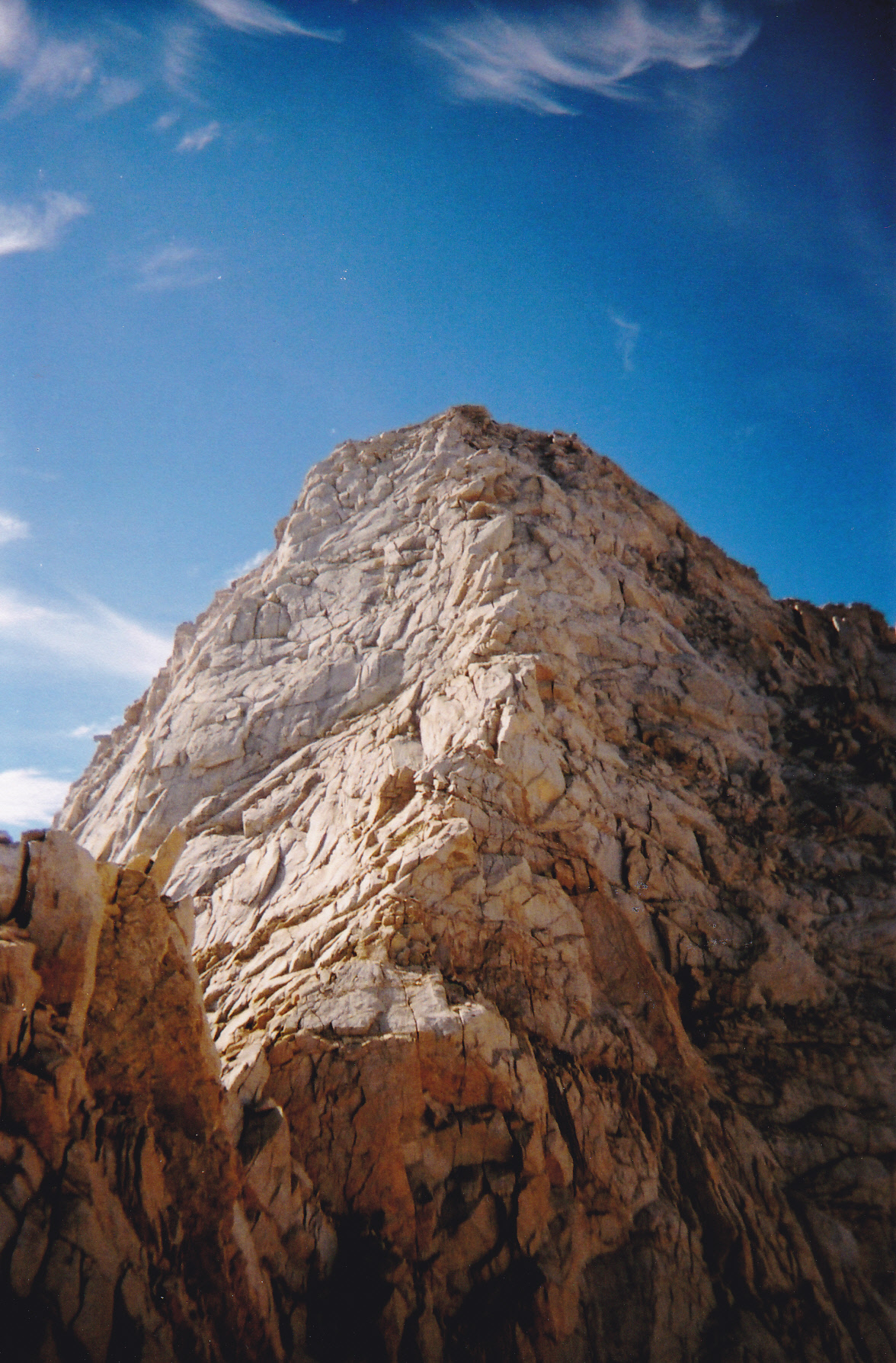
Near the end I sarcastically remarked, ‘If this isn’t the last pitch, I’m going down the way we came!’ After an ironic chuckle we rounded a corner and found ourselves on the summit. We each had different priorities: I frantically searched for the register, Jonathan fished for his camera, and Erik yelled at us to get moving for the descent! I find Erik’s guiding style highly productive: he is patient enough to teach and explain topics of interest in a friendly conversational style, but when the situation calls for it, he lets you have it. I respond very well to honest criticism and quickly signed the register. Time to boogie! ‘Put the selfie stick away, Jonathan!’ Erik yelled.
![Jonathan and I on the summit [photo by Erik]](http://bellokonthemoon.com/wp-content/uploads/2016/02/IMG_20150823_173848.jpg)
We had all heard the Lone Pine Peak descent horror stories, those poor scrags of climbers that had taken the wrong chute only to be cliffed out so tantalizingly close to the valley floor. Erik and I made an extra pass back and forth just to be absolutely certain we took the correct chute (we did). My advice regarding this matter is threefold:
- As you traverse southwestward across the summit plateau, there is a really tempting sucker chute before you get to the correct chute.
- The correct chute is steep class one. If you see anything remotely resembling class three, you have probably taken the sucker chute.
- The correct chute angles more to the left (to the west) than the sucker chute. You can just pick this out on an 80 ft USGS topographic map.
The sun was getting low in the sky and we balanced the prospect of not reaching the trail before dark against descending the loose chute safely. In the end it worked out all right as we had time enough to discuss the amazing play of Steph Curry while re-filling our water bottles at the creek. We found the trail easily and hiked our way down in the dark. Fittingly Jonathan stopped to puke in the bushes about halfway down. It had been a rough day for him but to his credit, he persevered and was in high spirits back at our cars. We both thanked Erik for guiding us up the mountain. I had a great time. Perhaps the most satisfying outcome of the trip, for me, was realizing that it was entirely possible that I could one day become one of those wackos hanging off the side of the mountain, climbing straight into the sky and freedom. Our alpine climb did not require herculean strength but rather emphasized route-finding, contemplation, and sound decision-making. Sometime in the early hours of the morning I fell asleep at a park and ride off the 14. Visions of mountain climbs on this still night in Palmdale…
The last chapter of this saga takes us to the nearly inconceivable Bear Creek Spire. Standing proudly at the head of Little Lakes Valley, this granite massif wears huge granite aretes, buttresses, and faces all tangled in beautiful symmetry. This mountain has been touched by the Hand of God.
After our successful guided climb on Lone Pine Peak, I was feeling confident enough to lead an easy alpine climb myself. Jonathan already had his sights set on Bear Creek Spire, so the Northeast Ridge was a logical choice for us. I looked up some reports about the route and uncovered ratings between 4th class and 5.6! This was somewhat unsettling, but the extended route descriptions provided by some of the more didactic report authors put me at ease. It seemed that any fifth class to be found on the ridge was easy, with only the last move onto the summit block warranting a 5.6 rating. Now that I’ve climbed the route, and especially considering that it’s a Norman Clyde first ascent, I prefer rating the climb, ‘Norman Clyde 4th class.’ Besides the most productive, useful aspect of rating a route is not in the absolute rating itself, but in the debate required to ascribe a rating. No need to get your harness in a bundle!
Armed with some perspective on the history of the route, Jonathan and I hiked up Little Lakes Valley with great anticipation. The approach was so easy that we found ourselves chit-chatting at length with fellow hikers and napping in grassy meadows. Jonathan prefers to take an extremely slow, absorbent pace through the mountains. You can tell he wants to soak up every last drop of beauty, and his ethos was infectious. I found myself appreciating the scenery that much more during our approach hike.
By afternoon we strolled into our high camp at Dade Lake and found a mega-party of climbers. It turned out the climbers were students at Prescott College; their regular curriculum had taken theme here, to the High Sierra, Dade Lake, Bear Creek Spire, ‘Are you kidding me?!’ I slept through most of my undergraduate lectures and spent the greater part of my master’s research slaving in window-less basement laboratories. These students certainly had their priorities sorted. And they were a friendly bunch. Upon our arrival, one of the instructors approached Jonathan and I and gave us a warm welcome. I appreciated the heads up that they would be ascending en-masse the North Arete and Northeast Ridge tomorrow. I was barely able to restrain myself from asking if I could sit in on his lecture. Bolstering the cordial relations between our parties, Jonathan recognized two of the students and together they re-lived a climb of Banner Peak and Mt Ritter, where they had met earlier this year.
Jonathan and I wandered over to a huge boulder which already sported a flat, sandy sleeping area. I spent the rest of the day building up the wind break, and come sunset, gazing upon the Spire. I sorely regretted not bringing a camera along, but acknowledged that even if this light could be captured perfectly through a glass lense, and put onto glossy paper, or a high definition electronic screen, the result could not possibly convey the awe I now felt, standing in such a place. This was a very special time and place to be a part of, but unlike any human institution, this Spire would stand for millions of years. I find strange solace in this permanence.

We were up with the sun and picked our way around Dade Lake toward the talus heaps that guard the climbing routes on the Spire. In a portent of things to come, Jonathan and I could not make up our minds which way to go around the lake. I insisted on going right as I had fully scouted this route the previous afternoon. However, all of the Prescott climbers were going left around the lake, which convinced Jonathan it was the correct way to go. He went left and I went right and we met up on the other side easily enough. Jonathan’s slow, methodical way of moving about the talus heaps started to wear on my patience. The slow pace was relaxing on the approach hike, but given my history of getting annihilated by storms high on mountains, I have come to associate speed with safety at high altitude. Compounding the large discrepancy in our preferred paces was Jonathan’s tendency to indulge in frequent, lengthy breaks to take pictures. Indeed I had listened many a time about his plans to create a more picturesque High Sierra guidebook that could match those of Colorado.

This dynamic continued throughout the climb; I enjoyed bursts of really fun scrambling moves on the ridge, only to wait for Jonathan to catch up again. I couldn’t catch my rhythm – couldn’t get dialed in – couldn’t feel the mountain’s presence with all of these breaks. Where Jonathan faced outward, trying to capture light from faraway scenery, I preferred to face the mountain, looking inward to attain a deeper consciousness of how I related to my surroundings, focused only on the sequence of moves right in front of me. Jonathan and I are both huge fans of Star Wars. Maybe during our climb I should have quoted Master Yoda:
‘This one a long time have I watched. All his life has he looked away, to the future, to the horizon. Never his mind on where he was, hmm? What he was doing! Hmm. Adventure. Hah! Excitement. Hah! A Jedi craves not these things.’
After passing the prominent tower, I stubbornly insisted on staying right on the ridge crest. I realized around this time how spoiled I had become indulging my whims as a frequent solo scrambler. The crest consisted of wild, solid granite fins that looked so inviting to climb. However Jonathan indicated he was not comfortable climbing the fins unroped. Instead of offering to rope up and lead the pitch, I soloed the fins while Jonathan traversed around the left side of the fins behind the Prescott climbers. I topped out above the Prescott lead climber’s belay, which resulted in Jonathan and I becoming separated by their entire four man team! Not good! I had to take the blame for this one. As the last Prescott climber came up, we came to an agreement:
Prescott climber: This isn’t a good situation with you guys getting mixed up with our team.
Jeff: Yeah sorry about that!
Prescott climber: You guys should probably go ahead since we are pitching out this third class all the way to the top. Today we are practicing some alpine rope techniques, like using a strong stance for a belay.
Jeff: Sounds great. We can move ahead of you from now on. Jonathan, what do you say, are you ready to go?!
Jonathan: Nah, I’m good. Let’s take a break, Jeff. They can go ahead.
I’m thinking, ‘What?! Gah! I just want to feel the rhythm, feel the rhyme, get on up it’s climbin time! Oh well.’ Conveniently enough the route eventually presented many variations by which the summit ridge could be gained, giving us all much more room to breathe. I led two short pitches to gain the ridge, accidentally placing the first belay around an awkward bulge. As an inexperienced climber I lacked the intuition required for smart route-finding and logical rope management. So as Jonathan approached the belay, and removed the sling I had used to protect the bulge, he was faced with a short sideways swing onto my belay ledge. I had a nice, solid nut in a constriction and two good cams in an adjacent crack and was feeling really good about my anchor handling any direction of loading. So I said to Jonathan as he stood on the other side of the bulge, ‘Just weight the rope, man. I have you covered – nice and tight.’ But he just wasn’t listening! After much hemming and hawing, he awkwardly flopped around the bulge and swung out over the ledge. There was some pretty big air beneath this one, and Jonathan yelled out with terror. ‘Easy,’ I replied calmly, ‘I got you.’ The Prescott climbers looked over our way, alarmed at the sudden commotion. I had just caught my partner’s fall – actually held his life in my hands. ‘Her life was in your hands, Dude!’ I realized with humbling severity the meaning behind that old turn of phrase, ‘The Brotherhood of the Rope.’
As it happened I would have been perfectly fine scrambling this route. It was perfect for my first alpine lead climb. Besides building the anchors, I only placed two or three pieces while ‘leading’ the two short pitches to gain the ridge. Jonathan and I endured one last snafu while traversing the sloping ledge leading to Ulrich’s Face. (We had just downclimbed to the lower ledge, which was sloped at a more forgiving angle than the higher ledge.) I placed a nut to protect a difficult move off the belay and then went on my way across the easy lower ledge. After putting Jonathan on belay, he climbed above the nut and onto the ledge. I yelled back, ‘Jonathan you have to clean that nut!’
Jonathan: I couldn’t do it! You should have put a longer sling on it!
Jeff: What?!
Jonathan: Let me climb back down to get it!
Jonathan was unable to climb back down and clean the piece after trying for about ten agonizing minutes. Meanwhile I’m freezing my ass off at the shady belay.
Jonathan: Let me untie from the rope so I can just pull it through!
Jeff: No! Do not untie!
Jonathan: I can’t reach the nut! I’m gonna untie!
Jeff: Well at least wedge yourself in there safely first!
After more arguing Jonathan went ahead and untied himself from the rope, pulled it through the nut, and finally freed himself from the tyranny of my #12 nut placement. By the time we got to Ulrich’s Face I was so near my wit’s end from Jonathan’s shenanigans and running into hordes of Prescott climbers all day that I just climbed straight up a crack instead of zig-zagging across the face. One last hip belay on my end and we were beneath the summit block!

Despite our troubles Jonathan and I had stuck together and made it to the summit of this beautiful Spire in a relatively safe manner. I noticed a Prescott climber elegantly face climb the block, not even bothering to grab the top edge to complete a secure mantle in the face of withering exposure. I was not so graceful and reached up for the edge as soon as I could, essentially whale humping the block. I yelled out happily, ‘I! AM! SCARED!’ The Spire had broken me down to my core. I was more nervous watching Jonathan climb the block than I was climbing it myself. Yet another party of two climbers ran up and down the block and showed me how to tie a figure eight bend to join our two ropes together for the rappel. (Jonathan and I carried two 30 meter ropes, which had been created by his friend who cut a single 60 meter rope in half.) These climbers were convinced the figure eight bend was less likely to snag during the rope pull, and at least in this case it worked just fine. There were about 15 climbers all descending the talus leading to Cox Col. The Spire had seen many summits on this fine late summer day. I skipped all the way back to Dade Lake and left Jonathan far behind. I joked around with the two climbers we met at the summit block and now seem to recall that Biggie Smalls references were made more than a few times. The pertinence of Biggie’s lyrics to the climb was clear at the time, but now it eludes my dazed mind. I expressed my envy to the climbers of their easy descent with nice, light daypacks and then fell asleep on a large boulder.
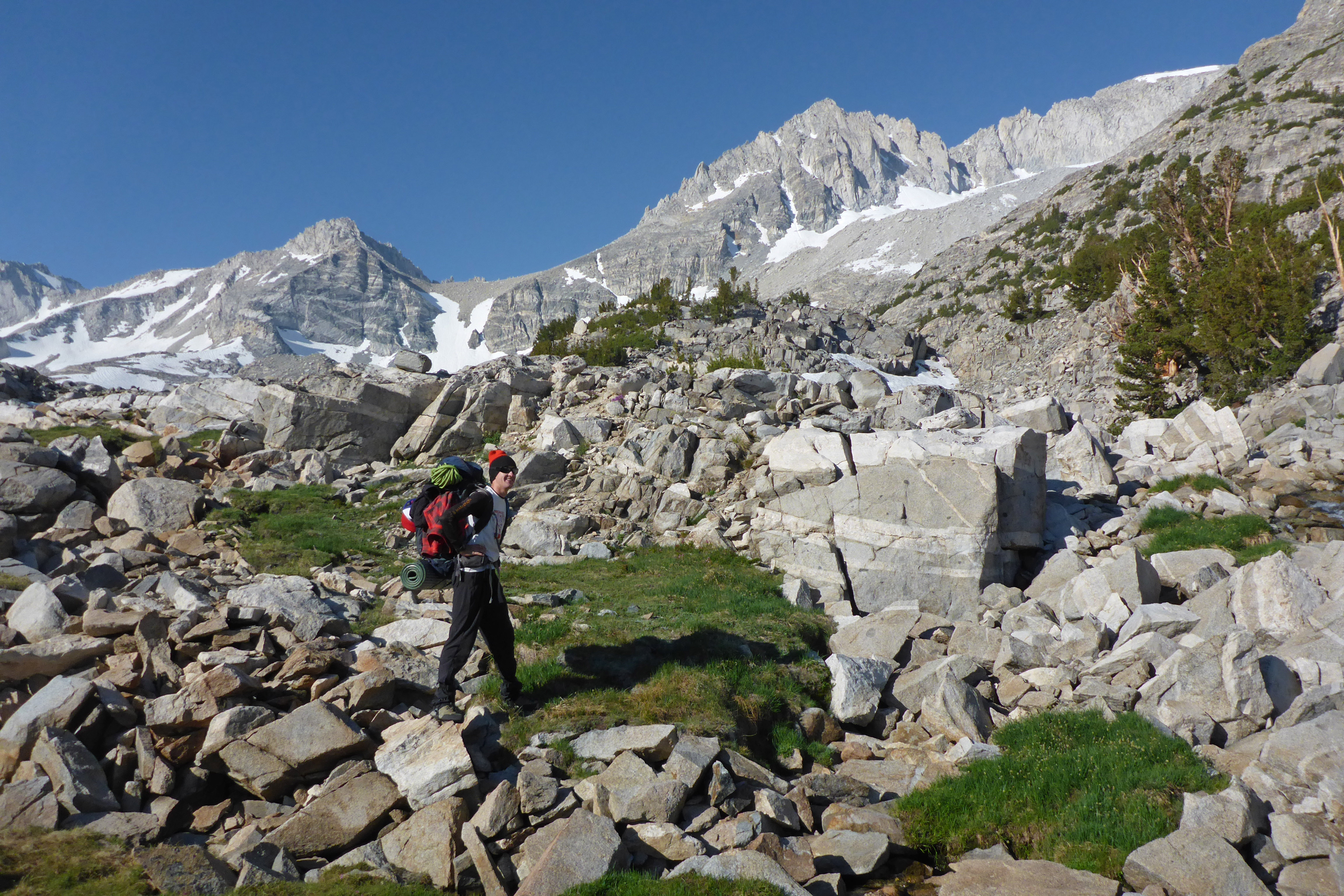
At long last Jonathan returned to Dade Lake. We packed up camp and reached the trailhead at nightfall, congratulating each other on a fine climb. There was never a point during the climb when I felt unsafe about what I was doing. I felt pretty good about this as my skills were finally, ever so slightly, catching up to my ambitions with respect to climbing technical routes in the High Sierra. I have a long way to go, but as they say the joy is in the journey, not the destination. I hope you enjoyed my story (JTTNRoLPPNeRoBCS) about how I learned, and am still learning, to climb. If you are a simple Sierra scrambler like myself and get a woozy, shaky feeling in your legs when you look up at clean technical lines in the mountains, maybe my story will inspire you to try some of this stuff.
In the words of Kevin Garnett, ‘ANYTHING IS POSSIBLEEEEEEEEEEEEEEEEEEEEEEEE!!!’

